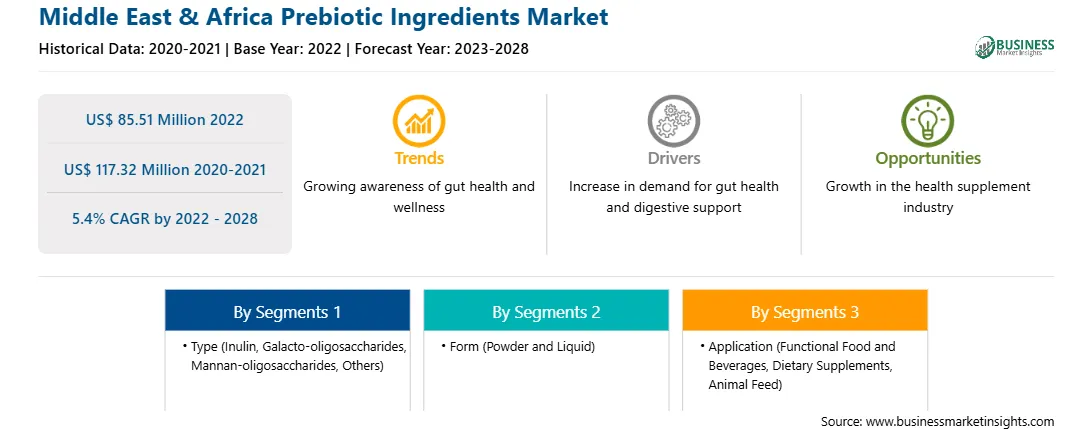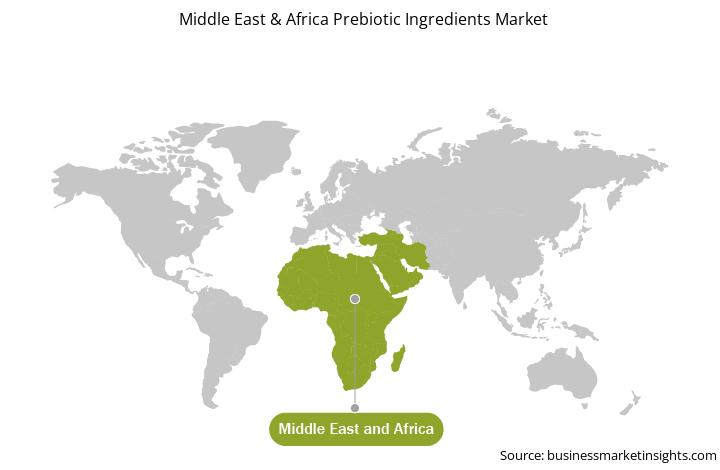The prebiotic ingredients market in Middle East & Africa is expected to grow from US$ 85.51 million in 2022 to US$ 117.32 million by 2028; it is estimated to grow at a CAGR of 5.4% from 2022 to 2028.
Over the past few years, awareness regarding environmental sustainability has increased significantly. The number of people adopting a vegan lifestyle and a plant-based diet is growing continuously. Consumers’ inclination toward cutting down the food of animal origin, such as meat and dairy products, is attributed to various factors, ranging from environmental sustainability concerns to ethical considerations to personal health objectives. This is likely to generate demand for prebiotic fibers, as they are either already present in plant-based products that are meant to replace animal-based diets or may be easily incorporated into them. Many prebiotic food products are suitable for vegans and people on other diets to eat. According to International Scientific Association for Probiotics and Prebiotics (ISAPP), Inulin and oligofructose are the proven plant-based prebiotics available in the market. Manufacturers are planning to introduce plant-based products by including prebiotic ingredients. Kellogg’s focuses on strengthening its immediate future by promoting its diverse range of plant-based fibers that nourish the human gut. Although various food products are now recognized as having prebiotic properties, several others, such as almonds, artichoke, barley, chia seeds, chicory, dandelion greens, flaxseeds, garlic, and oats, are being explored and used as a functional food. Prebiotics are found in many fruits and vegetables, especially those containing complex carbohydrates, such as fiber and resistant starch. All these factors have significantly contributed to increased sustainability concerns among consumers. Thus, plant-based food is emerging as a significant trend in the prebiotic ingredients market.
Strategic insights for the Middle East & Africa Prebiotic Ingredients provides data-driven analysis of the industry landscape, including current trends, key players, and regional nuances. These insights offer actionable recommendations, enabling readers to differentiate themselves from competitors by identifying untapped segments or developing unique value propositions. Leveraging data analytics, these insights help industry players anticipate the market shifts, whether investors, manufacturers, or other stakeholders. A future-oriented perspective is essential, helping stakeholders anticipate market shifts and position themselves for long-term success in this dynamic region. Ultimately, effective strategic insights empower readers to make informed decisions that drive profitability and achieve their business objectives within the market. The geographic scope of the Middle East & Africa Prebiotic Ingredients refers to the specific areas in which a business operates and competes. Understanding local distinctions, such as diverse consumer preferences (e.g., demand for specific plug types or battery backup durations), varying economic conditions, and regulatory environments, is crucial for tailoring strategies to specific markets. Businesses can expand their reach by identifying underserved areas or adapting their offerings to meet local demands. A clear market focus allows for more effective resource allocation, targeted marketing campaigns, and better positioning against local competitors, ultimately driving growth in those targeted areas.Middle East & Africa Prebiotic Ingredients Strategic Insights

Middle East & Africa Prebiotic Ingredients Report Scope
Report Attribute
Details
Market size in 2022
US$ 85.51 Million
Market Size by 2028
US$ 117.32 Million
Global CAGR (2022 - 2028)
5.4%
Historical Data
2020-2021
Forecast period
2023-2028
Segments Covered
By Type
By Form
By Application
Regions and Countries Covered
Middle East and Africa
Market leaders and key company profiles
Middle East & Africa Prebiotic Ingredients Regional Insights

The Middle East & Africa prebiotic ingredients market is segmented by type, form, application, and country. Based on type, the Middle East & Africa prebiotic ingredients market is segmented into inulin, galacto-oligosaccharides (GOS), mannan-oligosaccharides (MOS), and others. Further, the inulin segment dominated the market in 2022. Based on form, the Middle East & Africa prebiotic ingredients market is bifurcated into powder and liquid. Further, the powder segment dominated the market in 2022. Based on application, the Middle East & Africa prebiotic ingredients market is segmented into functional food and beverages, dietary supplements, animal feed, and others. Further, the functional food and beverages segment dominated the market in 2022. Based on country, the Middle East & Africa prebiotic ingredients market is segmented into Saudi Arabia, the UAE, South Africa, and the Rest of Middle East & Africa. Further, the Rest of Middle East & Africa dominated the market in 2022.
A few of the key players dominating the Middle East & Africa prebiotic ingredients market are Cargill, Incorporated; DuPont; Ingredion; Nexira; and SOLACTIS.
The Middle East & Africa Prebiotic Ingredients Market is valued at US$ 85.51 Million in 2022, it is projected to reach US$ 117.32 Million by 2028.
As per our report Middle East & Africa Prebiotic Ingredients Market, the market size is valued at US$ 85.51 Million in 2022, projecting it to reach US$ 117.32 Million by 2028. This translates to a CAGR of approximately 5.4% during the forecast period.
The Middle East & Africa Prebiotic Ingredients Market report typically cover these key segments-
The historic period, base year, and forecast period can vary slightly depending on the specific market research report. However, for the Middle East & Africa Prebiotic Ingredients Market report:
The Middle East & Africa Prebiotic Ingredients Market is populated by several key players, each contributing to its growth and innovation. Some of the major players include:
The Middle East & Africa Prebiotic Ingredients Market report is valuable for diverse stakeholders, including:
Essentially, anyone involved in or considering involvement in the Middle East & Africa Prebiotic Ingredients Market value chain can benefit from the information contained in a comprehensive market report.